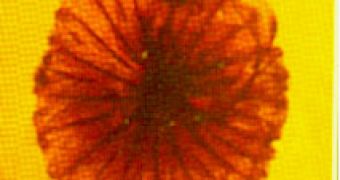Amber is priced not only in jewelry but also by scientists, too: it can offer glimpses of past life that other fossils cannot, as it can preserve soft tissues.
This is how Oregon researchers have found the world's oldest mushroom, embedded in a 100-million-year-old piece of amber. This is about 20 million years older than any other known mushroom fossils.
The fossil is even more interesting as it contains two parasites, one feeding on the mushroom and the other feeding on its first parasite.
"I was amazed enough with the mushroom. But then seeing the parasites was astonishing. No one has ever seen this three-tier association before." said George Poinar, a retired entomology professor in Corvallis, formerly of the University of California at Berkeley, a world leading authority in amber fossils, famous for popularizing the idea of extracting DNA from insects fossilized in amber (later used in the movie "Jurassic Park").
The mushroom was discovered in 2006 in Burma by Ron Buckley, a registered nurse, photographer and collector of amber fossils from Florence, Ky.
Amber represents fossilized tree resin, a sticky substance that oozes from both coniferous and some broad-leaved trees. Chemicals found in the resin are antibiotics that act like natural embalming compounds (Lebanese cedar resin was used in the embalming of ancient Egyptian mummies) and creatures trapped in it were wonderfully preserved.
"This shows how far back mushrooms - and the parasites that infect them - go. The ancient specimen is similar to pinwheel mushrooms (Marasmius species) that grow on the bark of modern trees. They dotted the trees 100 million years ago, so they probably were tasty treats for the dinosaurs to nibble on," said Poinar.
In 2006, the same team discovered the oldest bee ever, a 100-million-year-old specimen, from the same area in northern Burma, the place where amber is mined, and also flowery plants.
"The amber discovery is significant because mushroom fossils are rare. Ancient mushrooms - the fruiting bodies of fungi - lack bones or shells, so few survive. So the amber specimen can give us a lot of insight to what fungal diversity was at this time in the past and gives scientists an idea about fungi's role in forest ecosystems," added Joseph Spatafora, a fungi specialist and a professor of botany and plant pathology at Oregon State University.

 14 DAY TRIAL //
14 DAY TRIAL //